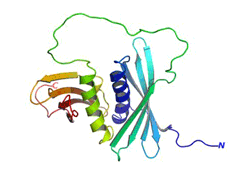
| Serial No. | GA-P0033HU |
| Species | Human |
| Specification | 0.1 mg/0.2mg |
| Brand | GenAsia |
| Origin | Shanghai |
| Price | US$350/US$620 |
Detailed information
1 Host: Escherichia coli (E. coli)
2 Species: Human
3 Protein Type: Recombinant
4 Synonyms: MCH2, Mch2, mCASP-6, xCaspase-6, mch2, caspase-6, zgc:112960, CASP6, casp6
5 Purity: 95% by SDS-PAGE
6 Application: WB、 Elisa、 Functional Studies
7 Background:
Caspase-6 (also know as Mch2) is a member of the caspase-family of cysteine proteases. Similar to other caspases, caspase-6 also exists in cells as an inactive proenzyme. During apoptosis procaspase-6 is processed at aspartate residues by self-proteolysis and/or cleavage by another caspase. The processed active form of caspase-6 consists of large (18 kDa) and small (11 kDa) subunits which associate to form the active enzyme. Active caspase-6 has been shown involving in the proteolysis of PARP (poly ADP-ribose polymerase), an enzyme that is involved in DNA repair and henomic maintenance. The recombinant active human caspase-6 was expressed in E. coli. The active caspase-6 is routinely tested for its ability to enzymatically cleave these two substrates Ac-VEID-pNA or Ac-VEID-AFC (ABIN412383).
8 Storage&Stability:
Avoid repeated freeze and thaw cycle.Store at 2-8℃ for delivery and store at -20 or -70℃ for future use. The loss rate of the target protein which describes the stability was determined by accelerated thermal degradation test.That is to incubate the protein at 37℃ for 48h and no obvious degradation and precipitation were observed.The loss of this protein is less than 5% within the expiration date under appropriate storage condition.
2 Species: Human
3 Protein Type: Recombinant
4 Synonyms: MCH2, Mch2, mCASP-6, xCaspase-6, mch2, caspase-6, zgc:112960, CASP6, casp6
5 Purity: 95% by SDS-PAGE
6 Application: WB、 Elisa、 Functional Studies
7 Background:
Caspase-6 (also know as Mch2) is a member of the caspase-family of cysteine proteases. Similar to other caspases, caspase-6 also exists in cells as an inactive proenzyme. During apoptosis procaspase-6 is processed at aspartate residues by self-proteolysis and/or cleavage by another caspase. The processed active form of caspase-6 consists of large (18 kDa) and small (11 kDa) subunits which associate to form the active enzyme. Active caspase-6 has been shown involving in the proteolysis of PARP (poly ADP-ribose polymerase), an enzyme that is involved in DNA repair and henomic maintenance. The recombinant active human caspase-6 was expressed in E. coli. The active caspase-6 is routinely tested for its ability to enzymatically cleave these two substrates Ac-VEID-pNA or Ac-VEID-AFC (ABIN412383).
8 Storage&Stability:
Avoid repeated freeze and thaw cycle.Store at 2-8℃ for delivery and store at -20 or -70℃ for future use. The loss rate of the target protein which describes the stability was determined by accelerated thermal degradation test.That is to incubate the protein at 37℃ for 48h and no obvious degradation and precipitation were observed.The loss of this protein is less than 5% within the expiration date under appropriate storage condition.








